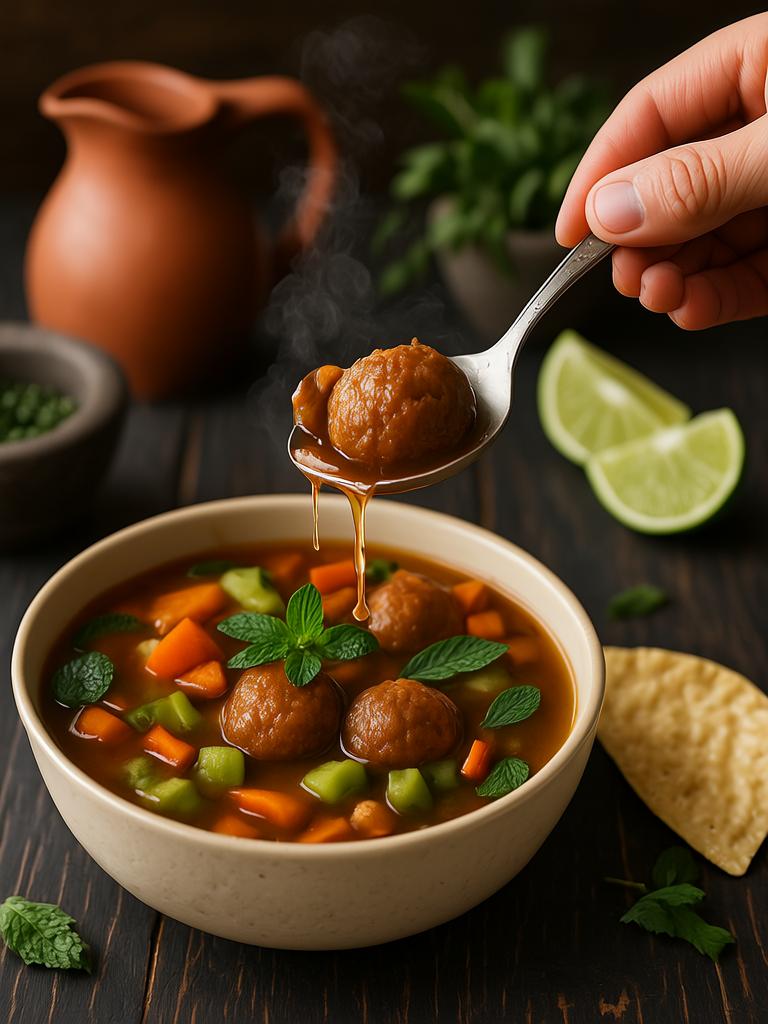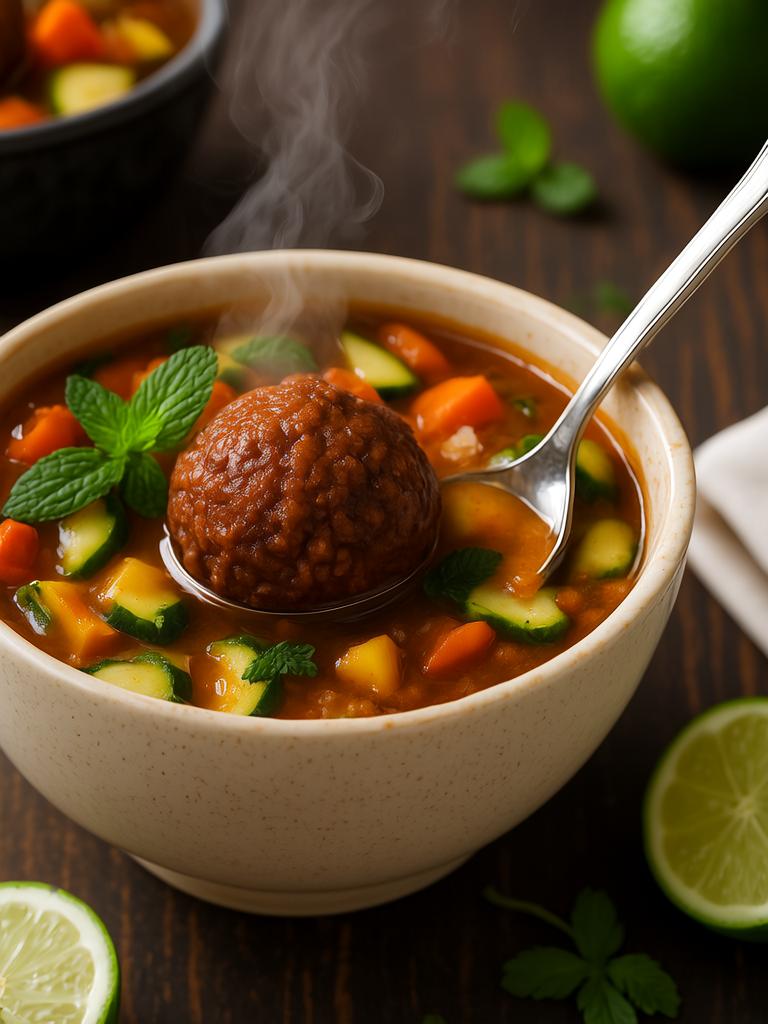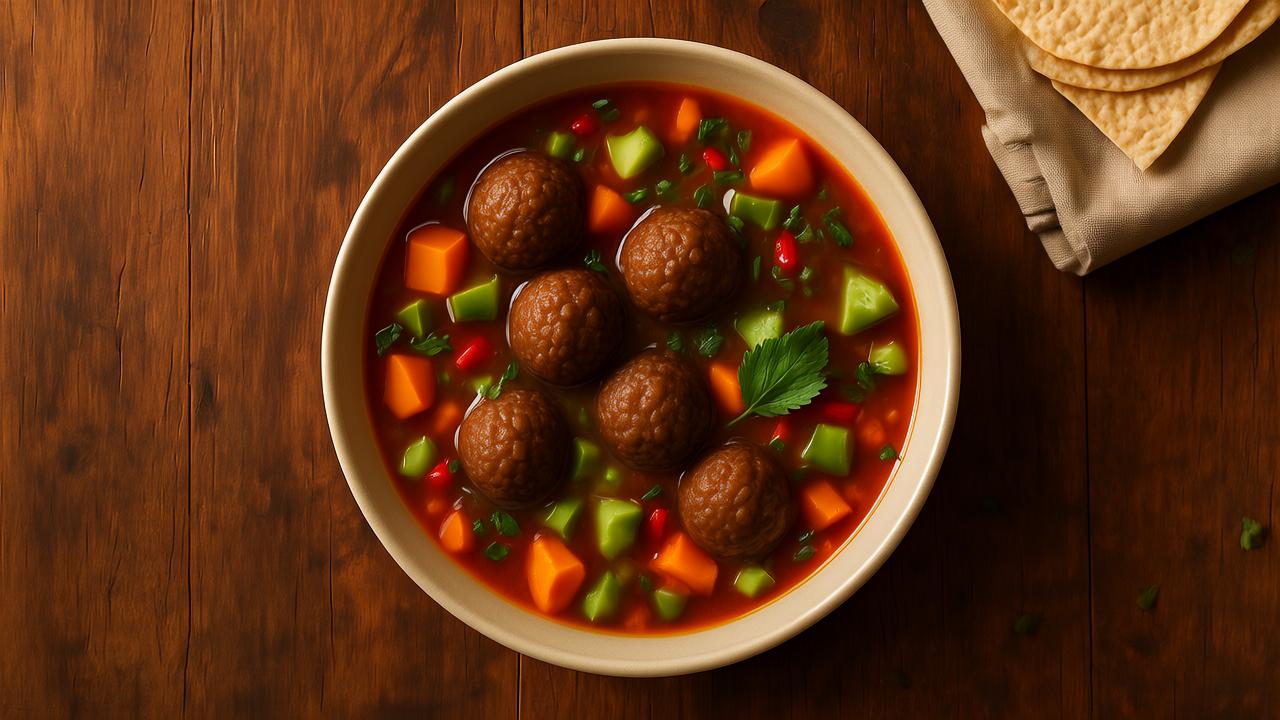It’s not just soup. It’s a cultural anchor. A warm bowl of albóndigas soup carries more than meatballs and vegetables—it carries memory. History. And when done right, it punches above its weight. This isn’t your average Tuesday night stew; it’s a labor of love in a broth. Made with tender meatballs spiced just right, infused with fresh mint, and bubbling with vegetables, traditional Mexican albóndigas soup is a humble masterpiece. Today, we’re cracking into what makes it tick—and how to do it right, from kitchen to soul.
This article’s for cooks who don’t just want to “make it.” They want to understand it. From culinary students to seasoned chefs, we’ll walk through history, meatball mechanics, flavor science, and why mint—yes, mint—isn’t just a garnish but a game-changer.
What Is Albóndigas Soup, Really?
The name sounds Spanish, and it is. “Albóndigas” literally means meatballs in Spanish. But the roots? They go deeper. The concept came from the Moors who introduced “al-bunduq”—Arabic for “little ball”—into Spanish cuisine around the 6th century. When Spanish colonists arrived in Mexico, they brought that meatball love with them.
But as Mexican cuisine tends to do, it took those influences and spun gold. Local cooks tossed in chayote, carrots, rice, mint—adding freshness and grounding earthiness. The result was something comfortingly rustic and impossibly nuanced.
The Role of Fresh Mint in Albóndigas: Not Just for Mojitos
You might raise an eyebrow here. Mint? In soup? Seems odd at first. But it’s not thrown in as a gimmick. Mint in Mexican albóndigas serves a very real purpose—cutting through the richness of the meatballs and fat in the broth.
Here’s what’s cool: mint brightens the whole soup. Think of it like a little green lightbulb of flavor. It gives the dish a clean edge. And if you skip it, honestly, you’re missing the whole point.
Professional kitchens in Mexico City or Oaxaca will tell you—mint isn’t optional. Some use hierbabuena (a native spearmint variety) which adds an herbal peppery zing. If you can get your hands on it, do. If not, a rough handful of fresh spearmint leaves does the job beautifully.

Anatomy of a Proper Albóndiga (The Meatball, Not the Soup)
This isn’t a Swedish meatball. Nor is it an Italian one. Mexican albóndigas are their own creature.
At its core, you’ve got:
- Ground beef or a blend with pork
- Cooked rice (this is important—raw rice won’t cook evenly)
- Egg for binding
- Fresh herbs—usually mint, sometimes cilantro
- Aromatics like garlic and white onion
Pro tip? Don’t overmix. You want a tender meatball, not a rubber ball. Just gently fold everything until it barely sticks together. You ever bite into a meatball that felt like a hockey puck? That’s from over-handling.
Some chefs like to pre-brown them. Others drop them raw straight into the simmering broth. Both are valid, but here’s the trick: if your broth is solid, you can skip browning. The meatballs will soak up all the herbal goodness.
Crafting the Broth: The Soul of the Soup
This is where most home cooks mess up. They rush the broth. Don’t.
Albondigas soup broth is usually chicken stock or beef stock-based. But not the boxed stuff. If you can, simmer your own bones for at least a few hours. You want something gelatinous and mineral-rich.
Into that golden liquid goes:
- Tomatoes (preferably roasted or blistered)
- Garlic cloves
- Onion
- Cumin and oregano
- A splash of lime juice right at the end
A touch of chile (like pasilla or guajillo) adds warmth but not necessarily heat. You’re not trying to blow anyone’s head off here—just warm them up from the inside out.
Here’s a real kitchen tip: strain your tomato-onion-garlic mixture after blending. Makes the broth silkier. Restaurant smooth.
The Vegetables: It’s Not Just Filler
Zucchini, carrots, green beans, sometimes potatoes or chayote. Albóndigas soup isn’t just a meatball delivery system. The vegetables aren’t secondary.
They should be cut uniformly. Not diced. Think chunky, but not clunky. About the size of a grape. Big enough to spoon up with a meatball in one bite.
Add them in stages. Carrots first. Zucchini last. You want things tender, not mushy. Nobody wants gray zucchini. That’s a culinary crime.
Real-life example? At a family-run fonda in Puebla, I watched a cook time each vegetable with a mental stopwatch. She’d been doing it for 40 years and could hear when the carrots were done. That’s the level of respect this soup demands.
Building Layers: Why Time Is Your Secret Ingredient
If you think this soup is just “throw everything in a pot,” you’re missing the magic. Traditional albóndigas soup is built in layers.
- First layer: aromatics. Sweat onions and garlic in a splash of oil.
- Second layer: tomato puree with toasted spices.
- Third layer: your stock—homemade, preferably rich with collagen.
- Fourth layer: meatballs, gently dropped in. Simmered, not boiled.
- Final layer: vegetables. Bright. Tender. Added last to protect texture.
You build the flavor up, not all at once. Like painting—one stroke at a time. Patience makes it sing.

Serving It Right: Garnishes Matter
Now here’s the thing. You’ve made a beautiful soup. Don’t ruin it by skipping the garnishes.
The classics?
- A squeeze of lime
- Hand-torn cilantro
- Thin-sliced white onion
- Maybe even a drizzle of salsa verde for heat
Serve with warm corn tortillas. Or if you’re feeling ambitious, fresh bolillos (Mexican rolls). Sop up that broth. Leave no drop behind.
Common Missteps (and How Pros Avoid Them)
Mistake #1: Overworking the meat. Like we said, light hands.
Mistake #2: Boiling the soup. That breaks the meatballs. Simmer, don’t boil.
Mistake #3: Skimping on mint. This is the heart, the whole signature. If it’s missing, it’s just soup with meatballs.
Mistake #4: Forgetting acid. Lime isn’t optional—it’s structural. It lifts everything. Like turning on a light.
Mistake #5: Using raw rice. Always precook it. Nobody wants crunchy bits inside meatballs.
Regional Variations: Albóndigas Across Mexico
In the Yucatán, you might find alcaparrado-style albóndigas with olives and capers.
In Baja, seafood albóndigas are a thing—shrimp and fish blended together, served in tomato-chile broth.
Some cooks toss in hardboiled eggs into the center of each meatball (very labor intensive but deeply satisfying when sliced open).
This isn’t a one-size dish. It’s like jazz. Every region adds its own note. And it always ends with people smiling around the table.
The Nutritional Breakdown: Surprisingly Balanced
This isn’t junk food. Done right, albóndigas soup is incredibly balanced. Let’s look at the macros for a standard serving (~2 cups with 3 meatballs):
- Calories: ~280–350
- Protein: 20g+
- Fat: 12–18g depending on meat
- Carbs: ~20g (from rice, veg)
It’s rich but not greasy. Hearty but not heavy. Throw in the fresh herbs and veggie fiber? You’re looking at a deeply nourishing dish.
Final Thoughts: Cooking with Heart, Not Just Heat
If you rush it, you’ll get soup. If you respect it, you’ll get something deeper. Traditional Mexican albóndigas soup with fresh mint and veggies is proof that comfort food doesn’t have to be boring. It can be elegant. Precise. Soulful.
Use good stock. Handle your meat gently. Don’t skip the mint. Build the broth in layers. And always—always—taste as you go.
One last story: a chef in Guadalajara once told me, “You don’t cook albóndigas soup. You listen to it.” Let it tell you what it needs. That’s when it becomes more than food. That’s when it becomes tradition.
Key Takeaways:
- Mint isn’t optional—it’s the balancing act.
- Use pre-cooked rice for tender, structured meatballs.
- Build the broth in flavor layers—no dumping everything in at once.
- Simmer, don’t boil. Respect the meatballs.
- Serve with lime, cilantro, and maybe a little onion crunch.
Next time you’re planning a hearty dish, skip the overdone stews. Make albóndigas soup. Make it slow. Make it honest. And let the mint do its magic.
FAQs
What is albóndigas soup made of?
Albóndigas soup is made with meatballs, fresh mint, vegetables, and a tomato-based broth.
Why is mint used in albóndigas soup?
Mint adds brightness and cuts through the richness of the meatballs and broth.
Can I skip the rice in the meatballs?
No, rice is essential for texture and helps bind the meatballs properly.
Should I brown the meatballs before adding to the soup?
You can, but traditionally they’re simmered raw in the broth for tenderness.
What kind of meat is best for albóndigas?
A mix of ground beef and pork offers the best flavor and texture.
Is it necessary to make homemade broth?
While not required, homemade broth adds depth and authenticity to the soup.
How do I avoid mushy vegetables in albóndigas soup?
Add vegetables in stages, starting with the firmest ones like carrots.
Can I use dried mint instead of fresh?
Fresh mint is highly recommended, but dried can work in a pinch—use sparingly.
Is this soup spicy?
Not usually—it has warmth from chiles but isn’t meant to be overly spicy.
What do I serve with albóndigas soup?
Warm corn tortillas or bolillo rolls pair perfectly for soaking up the broth.
How long does albóndigas soup last in the fridge?
Stored properly, it stays good for 3–4 days and tastes even better the next day.
Can I freeze albóndigas soup?
Yes, but freeze it without the vegetables for best texture when reheated.
Why do my meatballs fall apart in the soup?
Overmixing or boiling too hard can cause them to break—handle gently and simmer.
What vegetables work best in albóndigas soup?
Carrots, zucchini, potatoes, green beans, and chayote are all traditional choices.
What’s the origin of albóndigas soup?
It has Moorish-Spanish roots and was adapted in Mexico with local flavors and ingredients.

Mariana is a passionate home cook who creates delicious, easy-to-follow recipes for busy people. From energizing breakfasts to satisfying dinners and indulgent desserts, her dishes are designed to fuel both your body and hustle.
When she’s not in the kitchen, she’s exploring new flavors and dreaming up her next recipe to share with the Foodie Hustle community.

